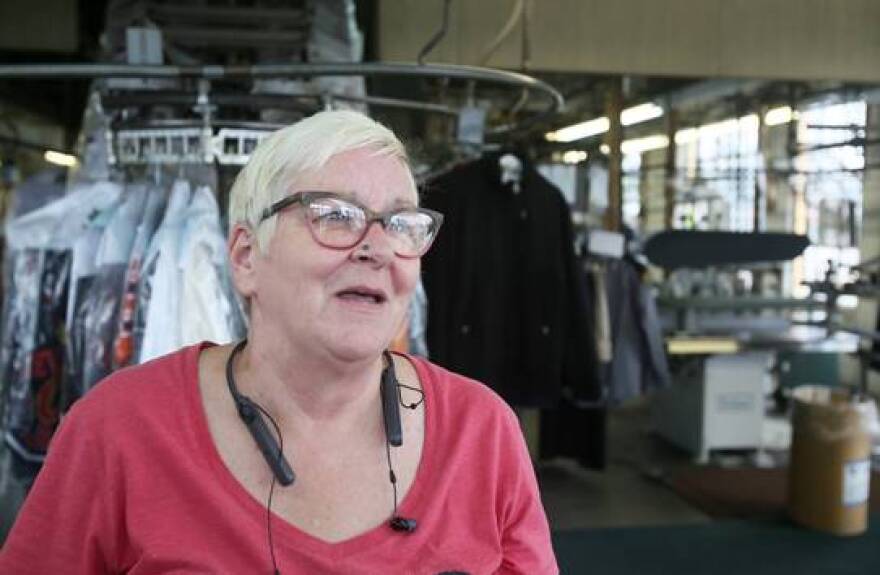What’s the matter with Akron?
“I think here where I work it’s probably the crime and then — second — the roads,” Rebecca Atkinson said with a disconcerted laugh. The manager of Maple Valley Cleaners on Copley Road recently moved from a West Akron apartment to a "more residential area" in Firestone Park, where it’s “a little quieter” and fewer people rent.
In her 18 years on the job, she’s watched robberies rise and business decline. “It’s slowly slipping away,” she said.
On the front door of the vibrantly painted dry cleaner is a city sign for the Great Streets Initiative. The business is one of 35 awarded facade grants this year. Maple Valley shops took a third of the new grants offered in 10 Akron business districts. Down the street, philanthropic groups and a newly formed community development corporation will test drive economic revitalization ideas this summer.
Still, the city could do more to market and make it safer for companies that keep their doors open to the public, Atkinson said. “I think all of Akron has things going on. But they need to pay more attention to the businesses over here.”
Identifying the challenges, understanding the problems
Atkinson nailed three top challenges for Akron: fixing streets and other public infrastructure, quelling crime and building up the economy, according to data released by the Center for Marketing and Opinion Research (CMOR) exclusively to the Beacon Journal/Ohio.com. The public opinion research is helping to inform a collaboration with other local media and the public, culminating in April with a series of community conversations geared toward finding solutions.
First, though, the problems have to be understood and owned.
CMOR isolated 300 respondents in its annual Summit Poll to produce an Akron edition of its Community Pulse report, which usually comes out in the fall. There’s a 5 percent margin of error when drilling down on only Akron respondents. Still, it's a fairly representative sliver of the city.
More than 70 percent have lived in Akron or Summit County for 20-or-more years. Two-in-five rent. Three-in-five earn less than $50,000 a year. And more than two-thirds are solidly working age (24-to-64 years old).
The right or wrong track
Asked if things in Summit Count are headed in the right direction, nearly equal shares of black and white Akron residents said "yes" 60 percent of the time, though whites were 40 percent more likely to think positively about job opportunities and the local economy.
The youngest respondents — born from 1995 to 2001 — were the only age group with more than half (51.4 percent) saying the city and region are on the wrong track. That negative outlook is shared by nearly half of those who earn less than $25,000 a year, rent, are unemployed or have not gone beyond a high school education.
For only the second time in the poll’s 13-year history, Akron residents are more concerned about how their government is serving them, from fixing roads and sewers to keeping utility bills affordable, than any other problem area. The poll was taken at the usual time, from mid-February through early March — only weeks after the city apologized for its botched snowplowing efforts in January.
The economy and unemployment, an overwhelming concern from 2007 through 2012, was knocked into third place this year.
The opiate crisis was the greatest concern last year. Akron families had been reeling from a wave of overdoses pummeling the city since the summer of 2016. City Hall and safety forces answered by forming Quick Response Teams to get victims into treatment and by equipping all first responders with Narcan, an overdose antidote.
The rate of overdose deaths in Akron last year was still five times higher than in Cuyahoga Falls and 11 times higher than in Barberton but the total number of deaths had tumbled from 182 in 2016 to 24 in 2018.
After a moment to acknowledge the progress, Mayor Dan Horrigan said in his State of the City speech last month, “There is still a lot of work to do."
Loading...
This story is part of a collaborative effort between the Beacon Journal, The Devil Strip and WKSU looking at the issues facing Akron residents this election year.

RSVP to attend one of the public conversations either online at https://www.ohio.com/forums or with reporter Doug Livingston at dlivingston@thebeaconjournal.com or 330-996-3792.



